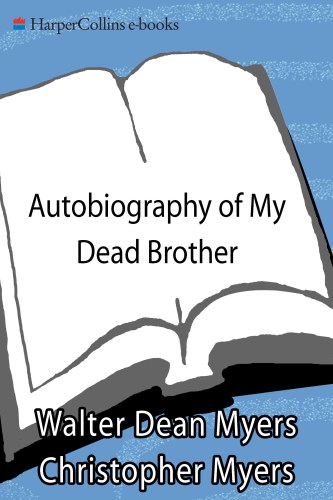
Autobiography of My Dead Brother
فرمت کتاب
ebook
تاریخ انتشار
2010
Lexile Score
730
Reading Level
3
ATOS
4.9
Interest Level
9-12(UG)
نویسنده
Christopher Myersناشر
HarperCollinsشابک
9780062046895
کتاب های مرتبط
- اطلاعات
- نقد و بررسی
- دیدگاه کاربران
نقد و بررسی

September 19, 2005
Myers mines the themes he explored in his Scorpions
and Monster
here, but with less subtlety. Jesse, 15, chronicles the demise of his "blood brother," Rise, in the titular illustrated "autobiography." While readers do not see enough of their early friendship to understand why Jesse continues to care for Rise, what unfolds more credibly is the growing friendship between the narrator and CJ. Like Jesse, CJ joins the benign-seeming Counts, a group going back more than 40 years to the days of "black social clubs." However, another group member has plans other than social get-togethers. Soon Mason (who "just felt like trouble") holds up a bodega and, after he lands in jail, expects the Counts to "rough up" the store owner so the man won't testify. Rise winds up dealing coke, while Jesse, his mother and a cop restate the book's message that "almost everything that was going down wrong in the hood was based on people dealing." Jesse's parents seem vague, and the motives of Rise's murderer, a kid called Little Man remain unclear. But perhaps these elements simply bolster the seemingly random acts of violence in Jesse's world. What comes through clearly is that CJ and Jesse have a way out—CJ through his musical talents and Jesse with his artwork, nicely demonstrated in Christopher Myers's black-and-white drawings, as well as in the father-son team's clever comic strips. Ages 14-up.

Starred review from August 1, 2005
Gr 8 Up -Fifteen-year-old Jesse lives a clean and relatively careful life in contemporary Harlem. His best friend and honorary brother, Rise, is two years older and plays life faster and looser. The boys belong to a social club inherited from the men of the older generation. The Counts aren't a gang and the members tend to have a variety of aesthetic interests. Jesse is devoted to cartooning and sketching while C. J. is a fine musician. Rise, however, it seems to Jesse, has begun to lead a second life that doesn't include him or The Counts. Myers's story of urban violence and wasted youth unfolds inexorably, but the relationships among his characters -Jesse and his frightened parents; C. J. and Jesse; a local cop and the neighborhood boys; Jesse and a love-starved but sexually knowing girl -are nuanced and engaging rather than predictable. The black-and-white artwork throughout includes both realistic sketches of Jesse's friends and a cartoon-strip take on Rise, adding a dimension that expands readers' views of Jesse's world and of the conflicts presented to the boys. This novel is like photorealism; it paints a vivid and genuine portrait of life that will have a palpable effect on its readers." -Francisca Goldsmith, Berkeley Public Library, CA"
Copyright 2005 School Library Journal, LLC Used with permission.

June 1, 2005
Gr. 8-11. Funerals for young black men, both murdered in drive-by shootings, begin and end Myers' sobering story about contemporary Harlem teens. Fifteen-year-old Jessie has always seen slightly older Rise as a hero, and the boys made a blood-brother bond as children. Then Rise pulls away, starts dealing drugs and "fronting cool," and Jessie struggles to find his old friend beneath the new persona. His search leads him to art, which is his great talent, and he begins to create a biography of Rise in pictures. Frequent and striking black-and-white illustrations, done by Christopher Myers, depict pivotal moments from the boys' youth; there are also comics-style panels, in which a bird-boy character asks how best to live and communicate truthfully. The plot, which drifts a bit, isn't the focus here. What will affect readers most is Jessie's sharp, sometimes poetic first-person voice and the spirited, rhythmic dialogue of other vivid characters, who ask piercing questions about how to survive the violence and hopelessness rooted through a neighborhood's generations.(Reprinted with permission of Booklist, copyright 2005, American Library Association.)

























دیدگاه کاربران